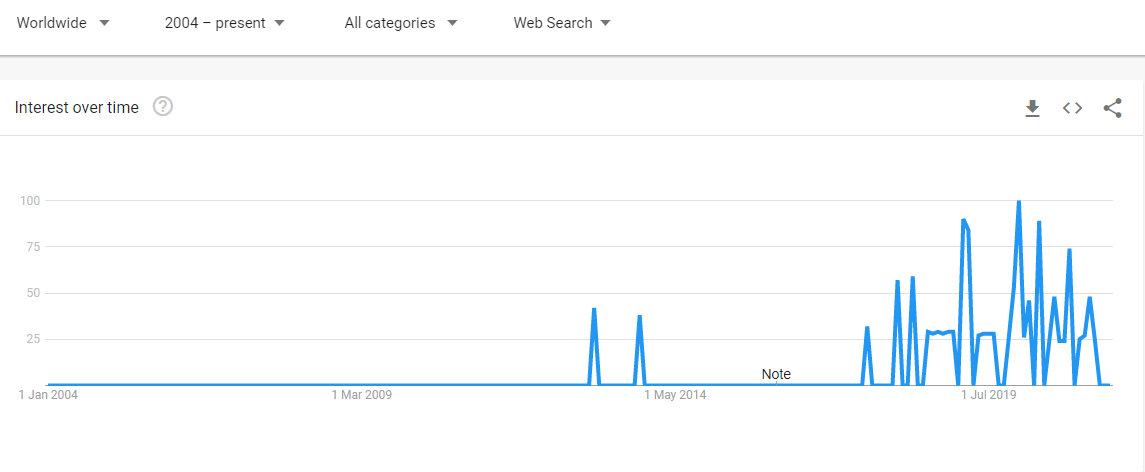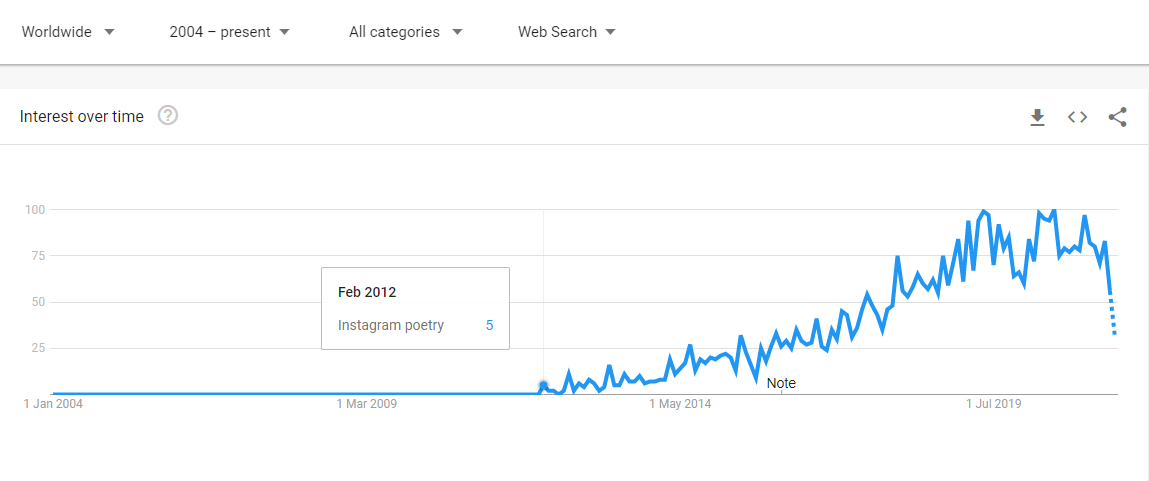
Your Guide to Instagram Poetry
This article is, mostly, about Instapoetry, but I need to get something off my chest before I dive into the ways Instagram poetry has become so popular: just because something doesn’t rock your boat, doesn’t mean it has no value.
Instagram Poetry Is Real Poetry
Humans don’t always deal well with change, especially changes we haven’t planned for. It is, therefore, no surprise to see older generations challenging the value of what younger people are doing.
As a Millennial that likes to be “down with the kids,” I am actually fascinated by how fast Gen Z understands technology, how much fun they are having online, and how they often use these tools to actually fight for causes, and educate themselves.
I also think it is necessary to keep up with the times, or we are doomed to grow old very fast, and very lonely, shouting angrily at a cloud. As Dylan once said:
“Come mothers and fathers
Throughout the land
And don’t criticize
What you can’t understand
Your sons and your daughters
Are beyond your command
Your old road is
Rapidly agin’.
Please get out of the new one
If you can’t lend your hand
For the times they are a-changin’.”Bob Dylan, “The Times They Are a-Changin'”
With the rise of social media, the generation gap issue seems to have become more prominent than ever: although social media is the new way we consume media, social media careers are very often seen as less serious, even as a mere hobby, even though there are a lot more kids nowadays consuming information and entertainment through YouTube than through regular TV channels.
Obviously, unlike terrestrial TV, almost anyone can create YouTube content, but this rise in online content allows us to have more control over exactly what we choose to surround ourselves with.
People looking down at things is not a new concept, and Instapoetry isn’t safe from the prying eyes of those who claim to know what Real Poetry ™ is.
Poetry, I believe, more than any other form of literature, is elitist. Or maybe poetry isn’t, but those dictating what poetry should, or shouldn’t be, are.
Many of those who are known today as famous poets, barely made a penny from their work back in the day, and poets tend to be seen as these mysterious, troubled souls, who live in a plane far beyond that of regular human beings.
Again, with the rise of social media, that is slightly changing, and you can follow more modern takes on poetry in several channels, like Poetry Foundation, or Button Poetry, if slam poetry is more your thing.
But poetry is not the easiest form of writing, therefore also not the easiest thing to read. A single sentence in a poem can have different meanings to different people, and even be a bit obscure to the poet itself. It is, therefore, no surprise, that poetry is often gatekept.
Let’s Talk Instagram Poets
Gatekeeping poetry (and literature, in general) is a very, very old concept, and the disregard a lot of Instapoets have to deal with rose with the trend. I’ve experienced this for the first time through social media.
From 2012 to 2016 I’ve spent a lot of time on Tumblr. Like, a lot. That’s where I stumbled upon fan fiction and fanart – another valid form of art that is completely looked down at unless created by some white dude centuries ago – and I once found myself enthralled in a beef between some Real Real Poets ™ and their arch enemies: the (Insta)poets.
I wasn’t following any poetry account at the time, but sometimes the algorithm throws something your way in 2013 that you can use in an essay in 2021, and I eagerly checked Tumblr daily for developments. The drama went as follows: two Real Poets ™ decided to play a little game. They came up with a “fake poem” and uploaded it to the platform. The poem was then reblogged a significant amount of times, with praising comments and hashtags. It basically became viral. A few days later the Real Poets ™ revealed to their followers – and those, like me, who were thrown in the middle of the drama – that the poem, so acclaimed and reblogged, was not a real poem, but some shitty poem they had come up with, to prove that anyone could write a poem without structure or rules, and still get a ton of praise. Basically, proving that people will like any shit they encounter, as long as it feels profound, even if it’s just a bunch of bullocks.
Now, I’m not even going into how freaking out of bounds this felt at the time, but if this sounds familiar, that’s because it is, especially for those who have followed the rise in Instapoetry of the last couple of years.
Andrew Lloyd wrote an article for Vice about how they faked their way as an Instagram poet.
Now, did these people really fake it? I dunno, but it seems to me that poetry – any art form, really – is not defined by those who make it, but by those consuming it.
Do I like all Instapoetry I come across? Absolutely not. But neither do I like every piece of literature I read, no matter how much people say they’re of “good quality”.
Of course, there is no denying that women being the ones mostly creating and consuming Instagram poetry is a factor defining the way the world tends to review this sub-genre. After all, god forbid a good chunk of women like anything and be taken seriously. Especially if that thing is accessible, with a certain aesthetic, and driven by feelings.
There’s nothing stopping us from appreciating Mary Oliver one day, and Istapoet007 the other. We have a lot more to gain from spending time enjoying things, rather than wasting our energy hating on something harmless.
Instapoetry is not taking the space of poetry. If you read further, you’ll find out it’s doing quite the opposite.
Now that my little rant cough little cough is out of the way, let’s take a look at some names and stats and find out how Instagram poetry grew, starting with its allure.
What Makes Instapoetry So Appealing
It Usually Deals With Social Justice Issues
Social media has been a big propeller of education around social justice issues.
Instapoetry speaks of feminism, racism, LGBTQIAP+, fatphobia and other important themes, and it is often a form of art that uses the word to fight personal and group oppression.
It’s Relatable
We like when literature speaks to us, it is why we read fiction, and poetry. Some poems seem to speak to our soul, to figure us out and give us words to explain what we are feeling but are unable to convey.
Instapoetry is all about human feelings and behaviours, translating them into short and simple sentences, and this is, more often than not, what pulls people to it.
It makes us feel less lonely knowing someone is going through exactly the same we are. And that can easily be achieved through a phone screen.
It’s Easily Available
It’s online, and it’s mostly free. If you search a few hashtags on Instagram or on your browser, you’ll have plenty of options to choose from in just a few seconds.
It’s up to you to weed it out and find what you enjoy.
It’s Welcoming Of Everyone And Easy To Understand
As I pointed out above, Instapoetry isn’t elitist and I also believe it doesn’t pretend to be more than what it is: short sentences strung together in order to invoke a feeling.
The greatest appeal of this sub-genre is its simplicity. The language used isn’t overly complicated.
Moreover, Instapoetry has created a surge in poetry interest, since it reaches a much broader population, so much so that while in 2012 less than 7% of the American population was a poetry consumer, in 2018, 28 million Americans (nearly 9% of the population) were poetry readers.
Intapoets: A Few Names To Remember
Rupi Kaur
When people hear about Instagram poetry there is probably one name that immediately pops into their minds, that of Rupi Kaur.
Kaur started as a slam poet in 2009, propelled to write as a way to deal with personal trauma. She posted her first poems on Tumblr and then moved on to IG in 2014, which was also when the first illustrations that usually accompany her writing started to be added to her poems.
Although her first book, Milk & Honey, was self-published in the same year, it was a school project about menstrual taboos and the objectification of women – and the response Kaur wrote after IG deleted one of her photos depicting menstrual blood – that made Kaur rise to global fame.
Milk & Honey was then picked up by a publisher, and as of June 2020 has sold over 3 million copies.
Atticus
That is the pen name of Duncan Penn, and he always wears a mask while performing.
He has two books published, which have become New York Times Best Sellers: The Dark Between Stars and The Truth About Magic. The first one has been translated into 14 languages.
Atticus supports a bunch of non-profit organisations, including To Write Love On Her Arms, which focuses on mental health services and awareness.
amanda lovelace
You may know lovelace from the princess saves herself in this one, but they have quite a few more books under their belt.
Their poems usually have a feminist approach, with themes such as trauma and healing, and although their first book was self-published, it was later picked up by the same publisher who offered Rupi Kaur a publishing house, Andrews McMeel Publishing.
Najwa Zebian
Zebian is known not only for her Instapoetry, but also for her TEDx Talks and her involvement in the #MeToo movement.
Mind Platter is her first work, first published in 2016, and it helped raise $2,300 for the Syrian Refugee Fund in London.
This book was later revised, and an extended version published by Andrews McMeel Publishing.
In 2019 she published Sparks Of Phoenix.
Lang Leav
Leav is the author of various poetry collections, and is also a novelist. Her first poetry collection was Love And Misadventure, self-published in 2013.
Her novel, Sad Girls, became a number one bestseller in fiction for The Straits Times, and she has illustrated several of her books.
Nikita Gill
Gill is one of the most famous Instapoets, with six volumes published, which often speak of love, and include feminist retellings of myths and fairytales.
Her works include Your Soul Is A River, Wild Embers: Poems Of Rebellion, Fire And Beauty, and Fierce Fairytales: & Other Stories To Stir Your Soul.
Analysing The Data Around Instagram Poetry
This is what Google Trends provides when you search for Instapoetry.

Source: Google trends
Although there was some rise in search back in 2014, the interest became a lot more regular around 2016. This is not strange, since Kaur rose to prominence around this time.

Source: Google trends
When you use the same tool to search for Instagram poetry, the results reflect the same medium and how it has been growing with Instagram, starting in 2012. Although Instagram was created in 2010, it was acquired by Facebook in 2012.
Is Instagram Poetry Coming To An End?
Instagram has announced recently that it is to become mostly a video app, a change that is not welcomed by most Instagram users, who were attracted to the app in the first place because of its image appeal.
If this really happens, things might take an unexpected turn to Instapoetry in the next couple of years. Maybe we will see a surge in more slam poetry on the app, or maybe people will find new ways to use the new algorithm in their favour.
There are some concerns about Instapoetry taking the place of classic poetry, since it is easier to digest and made for the masses, but let’s face it: those worries are as valid as people worrying kindles are going to replace paper books. In fact, there is space for both things to coexist, and neither is a replacement for the other.
And let’s be real: our pal Oscar Wilde would totally be posting his own musings on IG, had he been alive in the time of social media. The words on his deathbed would differ only slightly: “Either this new algorithm goes…or I do”.
If you have enjoyed this article, here are a few more you might like:
15 Instagram Poetry Accounts To Follow For Inspiration













